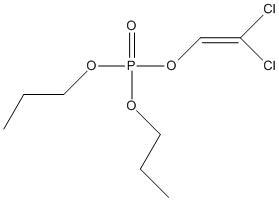PrDChVP
Derivative of Dichlorvos DDVP
General
Type : Organophosphate
Chemical_Nomenclature : 2,2-dichloroethenyl dipropyl phosphate
Canonical SMILES : CCCOP(=O)(OCCC)OC=C(Cl)Cl
InChI : InChI=1S\/C8H15Cl2O4P\/c1-3-5-12-15(11,13-6-4-2)14-7-8(9)10\/h7H,3-6H2,1-2H3
InChIKey : OBUPKOWLJDGPFA-UHFFFAOYSA-N
Other name(s) : Phosphoric acid, 2,2-dichlorovinyl dipropyl ester,2,2-dichloroethenyl dipropyl phosphate,2,2-Dichlorovinyl dipropyl phosphate,BRN 1711752,AI3-20740
MW : 277.08
Formula : C8H15Cl2O4P
CAS_number : 71-98-7
PubChem : 120168
UniChem : OBUPKOWLJDGPFA-UHFFFAOYSA-N

References (2)
| Title : Biosensor detection of neuropathy target esterase in whole blood as a biomarker of exposure to neuropathic organophosphorus compounds - Makhaeva_2003_J.Toxicol.Environ.Health.A_66_599 |
| Author(s) : Makhaeva GF , Sigolaeva LV , Zhuravleva LV , Eremenko AV , Kurochkin IN , Malygin VV , Richardson RJ |
| Ref : J Toxicol Environ Health A , 66 :599 , 2003 |
| Abstract : Makhaeva_2003_J.Toxicol.Environ.Health.A_66_599 |
| ESTHER : Makhaeva_2003_J.Toxicol.Environ.Health.A_66_599 |
| PubMedSearch : Makhaeva_2003_J.Toxicol.Environ.Health.A_66_599 |
| PubMedID: 12746135 |
| Title : A stable preparation of hen brain neuropathy target esterase for rapid biochemical assessment of neurotoxic potential of organophosphates - Makhaeva_1999_Chem.Biol.Interact_119-120_551 |
| Author(s) : Makhaeva GF , Malygin VV |
| Ref : Chemico-Biological Interactions , 119-120 :551 , 1999 |
| Abstract : Makhaeva_1999_Chem.Biol.Interact_119-120_551 |
| ESTHER : Makhaeva_1999_Chem.Biol.Interact_119-120_551 |
| PubMedSearch : Makhaeva_1999_Chem.Biol.Interact_119-120_551 |
| PubMedID: 10421494 |